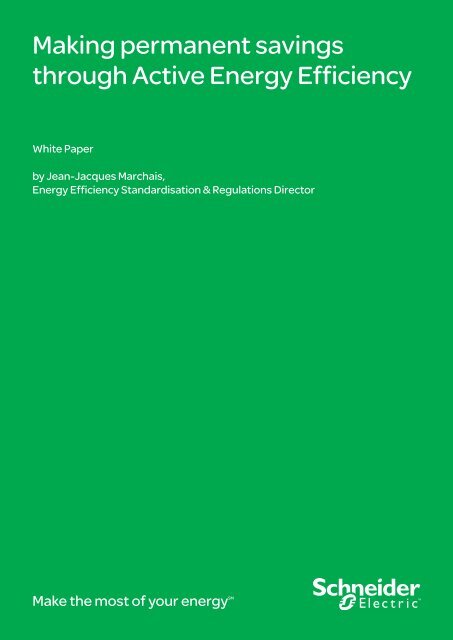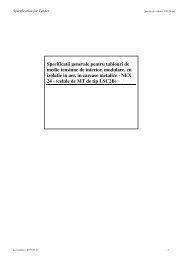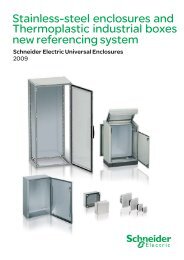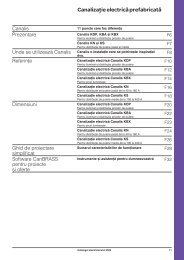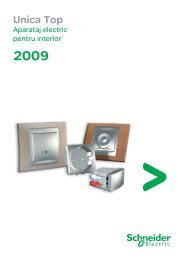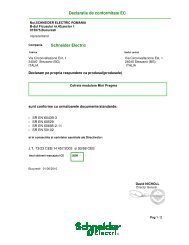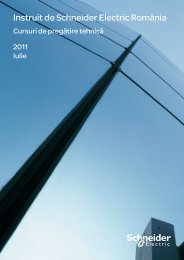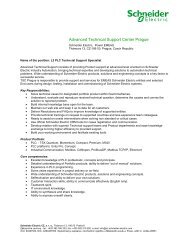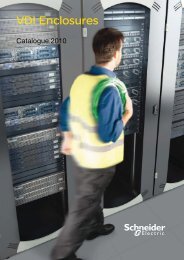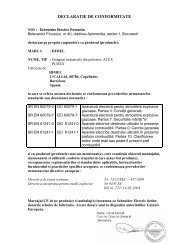Making permanent savings through Active ... - Schneider Electric
Making permanent savings through Active ... - Schneider Electric
Making permanent savings through Active ... - Schneider Electric
You also want an ePaper? Increase the reach of your titles
YUMPU automatically turns print PDFs into web optimized ePapers that Google loves.
<strong>Making</strong> <strong>permanent</strong> <strong>savings</strong> <strong>through</strong> <strong>Active</strong> Energy Efficiency<br />
<strong>Making</strong> <strong>permanent</strong> <strong>savings</strong><br />
<strong>through</strong> <strong>Active</strong> Energy Efficiency<br />
White Paper<br />
by Jean-Jacques Marchais,<br />
Energy Efficiency Standardisation & Regulations Director<br />
Make the most of your energy SM
Summary<br />
Executive Summary .................................................................................3<br />
Introduction .............................................................................................4<br />
The Current Situation ...............................................................................7<br />
Taking Action on Energy ..........................................................................9<br />
<strong>Active</strong> Energy Effi ciency in the Built Environment .....................................12<br />
<strong>Active</strong> Energy Effi ciency Solutions for Medium and Large<br />
Commercial Markets ................................................................................16<br />
Solutions for Residential and Small Commercial Markets .........................17<br />
Solutions for Industry and Infrastructure Markets .....................................19<br />
Conclusion ..............................................................................................21
<strong>Making</strong> <strong>permanent</strong> <strong>savings</strong> <strong>through</strong> <strong>Active</strong> Energy Efficiency<br />
Executive Summary<br />
This white paper argues strongly that meeting greenhouse gas emissions<br />
targets set within the Kyoto Protocol will fail unless <strong>Active</strong> Energy Effi ciency<br />
becomes compulsory.<br />
<strong>Active</strong> Energy Effi ciency is defi ned as effecting <strong>permanent</strong> change <strong>through</strong><br />
measurement, monitoring, and control of energy usage. Passive Energy<br />
Effi ciency is regarded as the installation of countermeasures against<br />
thermal losses, the use of low consumption equipment, and so forth.<br />
It is vital, but insuffi cient, to make use of energy-saving equipment and<br />
devices such as low-energy lighting. Without proper control, these measures<br />
often merely militate against energy losses rather than make a real reduction<br />
in energy consumed and in the way it is used.<br />
Everything that consumes power – from direct electricity consumption<br />
<strong>through</strong> lighting, heating, and, most signifi cantly, electric motors, but also<br />
in HVAC control, boiler control, and so forth – must be addressed actively<br />
if sustained gains are to be made. This includes changing the culture and<br />
mindsets of groups of individuals, resulting in behavioural shifts at work and<br />
at home, but clearly this need is reduced by greater use of technical controls.<br />
<strong>Making</strong> <strong>permanent</strong> <strong>savings</strong> <strong>through</strong><br />
<strong>Active</strong> Energy Efficiency<br />
White paper on Energy Efficiency - 3
<strong>Making</strong> <strong>permanent</strong> <strong>savings</strong> <strong>through</strong> <strong>Active</strong> Energy Efficiency<br />
Introduction<br />
That energy effi ciency is high on the agenda of most people is now clear.<br />
However, understanding of what energy effi ciency really involves and how<br />
energy saving initiatives can be implemented remains fragmented.<br />
For this reason some companies, such as <strong>Schneider</strong> <strong>Electric</strong> , have defi ned<br />
two approaches to energy effi ciency: Passive Energy Effi ciency and, more<br />
signifi cantly, <strong>Active</strong> Energy Effi ciency.<br />
For many, energy measures revolve around the consideration of thermal<br />
issues in the building fabric with remedies such as insulation, glazing, and<br />
heat loss countermeasures. For others, it is lighting, albeit often constrained<br />
to merely installing low consumption systems. Those with signifi cant heating<br />
requirements may see effi cient boiler systems as the answer.<br />
All of the above are laudable and necessary, but they are really only<br />
passive countermeasures that largely mitigate energy loss rather than<br />
the energy deployed.<br />
<strong>Active</strong> Energy Effi ciency can be achieved when energy-saving devices are not<br />
only installed, but controlled to use only the energy required. It is this aspect of<br />
control that is critical to achieving the maximum effi ciency. To illustrate, consider<br />
an energy-effi cient lamp that is left turned on in an empty room. All that is<br />
achieved is that less energy is wasted than would have been using an<br />
ordinary lamp!<br />
It is the management of energy use <strong>through</strong> measurement, monitoring, and<br />
control that effects <strong>permanent</strong> change. Moreover, compared with the costs<br />
(and technical skills necessary to avoid risks) of installing thermal solutions,<br />
energy control can be implemented at a relatively modest price and with a very<br />
rapid payback. This is especially true when measured against escalating energy<br />
prices – most energy control solutions can be amortized within a few years.<br />
Another very important factor that should drive <strong>Active</strong> Energy Effi ciency from<br />
this point forward is the need to meet ambitious carbon reduction targets<br />
set by those governments in alliance with the Kyoto Protocol. In the built<br />
environment, for example, it is a fact that unless existing buildings (as well<br />
as all new buildings) are made energy effi cient, it will simply be impossible<br />
to reach the targets set for 2020.<br />
4 - White paper on Energy Efficiency
<strong>Making</strong> <strong>permanent</strong> <strong>savings</strong> <strong>through</strong> <strong>Active</strong> Energy Efficiency<br />
Reducing greenhouse gas emissions was a global target set at the<br />
Kyoto Earth Summit in 1997 that was fi nally ratifi ed by 169 countries<br />
in December 2006.<br />
Under the Kyoto Protocol, industrialized countries have agreed to<br />
reduce their collective emissions of greenhouse gases by 5,2 per cent<br />
by 2012 compared to the year 1990. (Compared to the emissions<br />
levels expected by 2012 prior to the Protocol, this limitation represents<br />
a 29 per cent cut.) The target in Europe is an 8 per cent reduction<br />
overall with a target for CO 2<br />
emissions to fall by 20 per cent by 2020.<br />
This white paper looks at the approaches to <strong>Active</strong> Energy Effi ciency<br />
that can be applied within new and existing buildings – in commerce,<br />
industry, private, public, and residential – as well as in manufacturing,<br />
industry, and the transportation infrastructure.<br />
World energy-related CO 2<br />
emission <strong>savings</strong> by region in the 450 Scenerio<br />
45<br />
40<br />
35<br />
30<br />
Current Policies<br />
Scenario<br />
43 Gt<br />
25<br />
450 Scenario<br />
20<br />
22 Gt<br />
2008 2015 2020 2025 2030 2035<br />
China<br />
United States<br />
India<br />
European Union<br />
Middle East<br />
Russia<br />
Rest of world<br />
Total (Gt CO 2<br />
)<br />
Abatement<br />
2020 2035<br />
27% 35%<br />
11% 14%<br />
8% 8%<br />
13% 8%<br />
5% 5%<br />
2% 4%<br />
34% 26%<br />
3.5 20.9<br />
World energy-related CO 2<br />
emission <strong>savings</strong> by policy measure in the 450 Scenerio<br />
45<br />
40<br />
35<br />
30<br />
25<br />
Current Policies<br />
Scenario<br />
450 Scenario<br />
20<br />
2008 2015 2020 2025 2030 2035<br />
Abatement<br />
2020 2030 2035<br />
Efficiency<br />
End-use (direct)<br />
71%<br />
34%<br />
49%<br />
24%<br />
48%<br />
24%<br />
End-use (indirect) 33% 23% 23%<br />
Power plants<br />
Renewables<br />
Biofuels<br />
Nuclear<br />
CCS<br />
3%<br />
18%<br />
1%<br />
7%<br />
2%<br />
2%<br />
21%<br />
3%<br />
9%<br />
17%<br />
1%<br />
21%<br />
3%<br />
8%<br />
19%<br />
Total (Gt CO 2<br />
) 3.5 15.1 20.9<br />
Source: IEA – World Energy Outlook 2010<br />
White paper on Energy Efficiency - 5
<strong>Making</strong> <strong>permanent</strong> <strong>savings</strong> <strong>through</strong> <strong>Active</strong> Energy Efficiency<br />
European Union<br />
Emission Reduction Targets<br />
Kyoto commitment<br />
• Reduction of GHG emissions by 5% over the period 2008 - 2012<br />
March 2007 Spring Council Commitment<br />
• Reduce at least 20% of GHG emissions before end of 2020<br />
• Reduce at least 80% of EU emissions before end of 2050<br />
Target of 80% to 95% reduction of EU CO 2<br />
emissions is part of the 2050 Low Carbon Roadmap<br />
base = 1990 level<br />
6 - White paper on Energy Efficiency
<strong>Making</strong> <strong>permanent</strong> <strong>savings</strong> <strong>through</strong> <strong>Active</strong> Energy Efficiency<br />
The Current Situation<br />
Energy is consumed in a broad variety of ways<br />
across all sectors of life, from the provision of<br />
vital resources such as water, oil, and gas, to<br />
the lighting and heating in homes and the power<br />
required by industry and commerce. Much of that<br />
energy is consumed usefully, but huge amounts<br />
are wasted every day. It is the waste or ineffi cient<br />
use of energy that must be addressed.<br />
This white paper explores every aspect of the use<br />
of electricity and its impact on the environment.<br />
With greenhouse gas emissions in sharp focus<br />
around the world, the time has come for everyone<br />
to take action to economize on energy use by the<br />
intelligent application of technology to bring about<br />
<strong>Active</strong> Energy Effi ciency.<br />
At a European level, the Energy Performance in<br />
Buildings Directive (EPBD) has been recasted.<br />
This requires all buildings — including in the<br />
residential sector — to have energy ratings, similar<br />
to those seen on consumer white goods today,<br />
and to display these ratings in the building’s public<br />
areas or, in the case of residential buildings, within<br />
the documentation about the property. Some EU<br />
governments have stated that they expect an<br />
average 25% reduction in energy consumption<br />
from the introduction of this bill.<br />
As far-reaching as the legislation is, perhaps the<br />
biggest impact on businesses is the steep rise in<br />
the cost of energy. This poses a big problem for<br />
businesses as their profi t margins are squeezed<br />
and they are faced with the dilemma of whether<br />
to take the cut on their bottom line or to pass<br />
the cost increase <strong>through</strong> to the prices of their<br />
products and services, and therefore risk<br />
being uncompetitive.<br />
World Trade Index (WIT) implied volatility evolution<br />
40.0%<br />
37.5%<br />
35.0%<br />
32.5%<br />
30.0%<br />
27.5%<br />
Sources : US. EIA. CME Group<br />
Trade dates<br />
Dec-10 Contract month<br />
%<br />
15-Jan 10-Feb 8-Mar 3-Apr 29-Apr 25-May 20-Jun 16-Jul 11-Aug 6-Sep 2-Oct 28-Oct<br />
Additional price impact of the cost increase to the electricity<br />
producer in selected OECD+ countries resulting from the CO 2<br />
price in the 450 Scenario.<br />
Dollars per MWh<br />
120<br />
100<br />
80<br />
60<br />
40<br />
20<br />
CO 2<br />
price impact<br />
on fuel consumed<br />
Subcritical<br />
coal plant<br />
Supercritical<br />
coal plant<br />
More advanced<br />
coal plant<br />
Gas CCGT<br />
plant<br />
0<br />
-20<br />
-40<br />
Year:<br />
CO 2<br />
price:<br />
2015<br />
$20<br />
2020<br />
$45<br />
2025<br />
$75<br />
2030<br />
$105<br />
2035<br />
$120<br />
Reduced<br />
fuel price<br />
Net CO 2<br />
price<br />
impact<br />
Source = IEA - World Energy Outlook 2010<br />
White paper on Energy Efficiency - 7
<strong>Making</strong> <strong>permanent</strong> <strong>savings</strong> <strong>through</strong> <strong>Active</strong> Energy Efficiency<br />
Economies are readily possible in electricity<br />
generation and distribution, in its use, and in<br />
the way electricity can be used wisely to make<br />
effi ciencies in the use of other energy.<br />
The technology is available to maximize the<br />
effectiveness of electricity – including its<br />
application in controlling other energy usage<br />
– and the way in which it is distributed.<br />
The technology is there to control buildings’<br />
energy use in lighting, HVAC, building controls,<br />
and distribution. Lighting alone can account for<br />
40 per cent of a typical commercial enterprise’s<br />
electricity consumption. In offi ces, the explosion<br />
of information technology has also brought huge<br />
increases in electrical consumption, as has the<br />
preference for air conditioning systems. The<br />
prolifi c growth of data centres and new industries<br />
has also contributed to a dramatic rise in electrical<br />
power usage.<br />
In industry there are proven systems to reduce<br />
the power consumed by electric motor systems<br />
and to better control the application of electrical<br />
power <strong>through</strong>out a plant. Two thirds of electrical<br />
energy used by industry is used powering<br />
motors. In most countries less than 10 per cent<br />
of those motors have any kind of control and<br />
therefore cannot be slowed down or switched off<br />
automatically. Automation and the increasing use<br />
of electrical power, as well as ineffi cient hydraulic<br />
and pneumatic systems, have also grown in<br />
industrialized regions.<br />
In the home, new products enable lighting and<br />
heating controls that enhance living standards<br />
while saving electricity. In most countries, every<br />
single domestic dwelling (including individual<br />
apartments) contributes about 6.5 tonnes of CO 2<br />
each year — or, to put it another way, enough<br />
gas to fi ll six hot-air balloons! Yet, just switching<br />
off lights in unoccupied rooms could save 2.2<br />
tonnes per household. Computers, multiple<br />
televisions sets, modern electrical appliances,<br />
air conditioning, and even outside lighting and<br />
powered equipment have seen an exponential<br />
growth in consumption. Indeed, in many western<br />
economies, domestic electricity consumption<br />
outstrips even industrial use.<br />
In short, there is no reason not to be able to<br />
actively save electricity and other energy, provided<br />
there is the understanding of what is at stake, and<br />
a desire to do something about it.<br />
World energy demand is projected to rise by 36<br />
per cent by 2035 according to the World Energy<br />
Outlook 2010 – with the steepest increase coming<br />
from emerging economies, where the use of new<br />
electrical equipment is growing and where much of<br />
the populations of certain regions currently without<br />
electricity supplies will subsequently get them.<br />
It would be hard for most people to imagine a<br />
life without electricity, but that does not mean<br />
consumption cannot be controlled to deliver<br />
<strong>Active</strong> Energy Effi ciency. Indeed, without<br />
fi rm resolve to apply <strong>Active</strong> Energy Effi ciency<br />
measures, governments will be compelled to<br />
act legislatively in order to stand any chance<br />
of meeting Kyoto objectives and targets.<br />
8 - White paper on Energy Efficiency
<strong>Making</strong> <strong>permanent</strong> <strong>savings</strong> <strong>through</strong> <strong>Active</strong> Energy Efficiency<br />
Taking Action on Energy<br />
Everyone can take positive action to conserve<br />
energy or use it more wisely. The technology is in<br />
place, is relatively inexpensive in most cases to<br />
install, and provides rapid payback.<br />
On the premise that it is impossible to manage<br />
what cannot be measured, for large energy users<br />
– i.e. those other than residential – the <strong>Active</strong><br />
Energy Effi ciency process should start with an<br />
assessment of how and where energy is used,<br />
and how much of it is consumed.<br />
Fundamental questions that every<br />
organization must ask:<br />
• Is your organization equipped for<br />
energy effi ciency?<br />
• Changes in legislation and regulations are forcing<br />
building occupiers to get ready for carbon<br />
management. Is your staff trained?<br />
• Can your fi nancial teams fi nd their way <strong>through</strong><br />
any grants and incentives offered?<br />
Further assessment needed:<br />
• Do you know your requirements? In order to<br />
determine where to start, you need to know<br />
where you are now. However, taking advice<br />
can be a risk, unless the advice is backed with<br />
experience and knowledge. Begin with a study<br />
of your facilities built around your objectives.<br />
• Do the recommendations show you your<br />
route to energy effi ciency?<br />
• Do you understand the next steps?<br />
• Who delivers on energy effi ciency? You are in<br />
the driver’s seat, and with the right investments<br />
come <strong>savings</strong>. A poor implementation of an<br />
energy effi ciency scheme could signifi cantly<br />
reduce the potential for <strong>savings</strong>.<br />
• Do you have the resources to manage the<br />
procurement and installation of equipment<br />
and ensure you stay on track?<br />
• How would you evaluate your success?<br />
• Can you demonstrate this to your customers?<br />
• How much of your energy usage (including<br />
electricity, gas, water, oil and steam) can you<br />
account for?<br />
• Who uses your energy? Applying effective<br />
monitoring and targeting measures to energy<br />
consumption increases the success of energy<br />
effi ciency. However, without the buy-in of the<br />
people who are using energy in an organization,<br />
<strong>savings</strong> will be unsustainable.<br />
• Do you monitor awareness levels and<br />
attitudes towards <strong>Active</strong> Energy Effi ciency<br />
in your company?<br />
White paper on Energy Efficiency - 9
<strong>Making</strong> <strong>permanent</strong> <strong>savings</strong> <strong>through</strong> <strong>Active</strong> Energy Efficiency<br />
Expert audits of energy consumption, together<br />
with recommendations, are a good starting<br />
point. There are also some remarkably accurate,<br />
inexpensive, and easily installed consumption<br />
meters and controls now available that allow<br />
wasteful consumption to be better identifi ed<br />
and managed.<br />
ISO 50001<br />
In 2011, ISO will publish its new ISO 50001<br />
standard on Energy Management. This<br />
ISO 50001 standard will help establish<br />
management systems and processes to<br />
improve energy performance, in particular<br />
energy effi ciency. It will defi ne all requirements<br />
for an effi cient Energy Management system:<br />
how to develop and implement an energy policy,<br />
how to set objectives, targets and action plans.<br />
Variable-speed drives<br />
(VSDs)<br />
Because so much energy is consumed <strong>through</strong><br />
electric motors (about two-thirds of energy used<br />
by industry is consumed this way), variablespeed<br />
drives offer more effi cient management of<br />
energy-intensive applications such as ventilation,<br />
pumping, and compressed air installations. These<br />
products can be integrated into a new plant or<br />
used to upgrade existing equipment.<br />
<strong>Schneider</strong> <strong>Electric</strong> is committed to reducing<br />
energy consumption for its customers by offering<br />
a wide range of <strong>Active</strong> Energy Effi ciency products<br />
and services including advice, implementation<br />
strategies, monitoring and control solutions,<br />
and compliant products, all backed by excellent<br />
service to help maintain the <strong>savings</strong>.<br />
Energy audits<br />
Specialist energy consultants can measure and<br />
analyse energy consumption across a site or<br />
business and identify areas where energy<br />
<strong>savings</strong> can be made.<br />
Remote monitoring of<br />
energy consumption<br />
Energy managers or outside experts can remotely<br />
monitor energy consumption via wired or wireless<br />
links to the electrical installations. Based on data<br />
collected, these experts make recommendations<br />
that can be applied in real time.<br />
10 - White paper on Energy Efficiency
<strong>Making</strong> <strong>permanent</strong> <strong>savings</strong> <strong>through</strong> <strong>Active</strong> Energy Efficiency<br />
Technical solutions<br />
Technical solutions for optimizing electrical<br />
installations can include an extensive range<br />
of products, equipment, intelligent controllers,<br />
and control devices, but these are relatively<br />
inexpensive and can reduce the energy<br />
consumption of a commercial or industrial<br />
facility by typically 20 per cent.<br />
Lighting solutions<br />
Lighting control solutions that enable optimization<br />
of lighting systems in terms of both function<br />
(comfort and safety) and energy usage are<br />
available. Lighting makes up about half of the<br />
energy consumed in commercial buildings.<br />
Of even greater direct impact is power factor.<br />
Consumers with poor power factor waste<br />
electricity and incur additional costs – often<br />
without knowing it. Yet power factor correction<br />
equipment is easy to specify and install. A further<br />
consideration is that because capacitors lie at<br />
the heart of power factor correction equipment,<br />
as these devices deteriorate towards their natural<br />
half-life, upgrades may be required to maintain the<br />
highest possible power factor. Maintenance can<br />
therefore also be a key to maximizing <strong>savings</strong>.<br />
This white paper will now examine some specifi c<br />
sectors in which <strong>Active</strong> Energy Effi ciency<br />
measures can be applied.<br />
Power quality<br />
Two areas frequently overlooked are those of<br />
harmonics and power factor. These invisible<br />
characteristics of an electrical system can<br />
infl uence consumption, costs, and even<br />
life expectancy of equipment. There is<br />
European legislation relating to harmonics<br />
and electromagnetic interference, but even<br />
without such legislative concerns, it is beholden<br />
on businesses to ensure they do not pollute the<br />
electricity supply infrastructure with refl ected<br />
harmonics – in the UK these are measured<br />
all the way to the 50th harmonic!<br />
White paper on Energy Efficiency - 11
<strong>Making</strong> <strong>permanent</strong> <strong>savings</strong> <strong>through</strong> <strong>Active</strong> Energy Efficiency<br />
<strong>Active</strong> Energy Efficiency in<br />
the Built Environment<br />
<strong>Active</strong> Energy Efficiency in new public<br />
and commercial buildings<br />
It is diffi cult to understand these days why so<br />
many buildings are ultimately energy ineffi cient.<br />
There is the possibility for <strong>Active</strong> Energy Effi ciency<br />
to be considered at so many points in the<br />
design, development, construction, and eventual<br />
occupancy of a building. However, the differing<br />
vested interests of those involved in a building’s<br />
design and ultimate use, far from motivating<br />
energy management, can sometimes impede it.<br />
For instance, architects may consider energy<br />
conservation in terms of the materials and<br />
insulation regimes they adopt – that is, Passive<br />
Energy Effi ciency. It is rare for energy management<br />
controls to be considered at the design stage,<br />
since this tends to remain within the remit of the<br />
building services engineering.<br />
Construction companies are not always<br />
concerned with energy issues – their prime focus<br />
is in meeting budgets, cutting construction costs,<br />
and avoiding punitive penalty clauses. Only if<br />
strictly instructed do they readily embrace building<br />
systems or energy management during the<br />
construction phase.<br />
Where commercial property is concerned, even<br />
the end users sometimes care little for energy<br />
conservation or measurement. Often resident on<br />
short-term leases, the perception is that although<br />
it is they, the occupiers, that foot the energy bill,<br />
they are powerless, or too late, to do much<br />
about it.<br />
In short, getting proper and effective <strong>Active</strong> Energy<br />
Effi ciency controls onto the agenda is made<br />
easier when it is integrated with other compelling<br />
BMS offers. The same argument can bring about<br />
<strong>savings</strong> in the installation phases by enabling<br />
shared use of structured cabling, combined<br />
data and power cable pulls, and orchestrated<br />
accessory fi xes (power control, data outlets,<br />
HVAC control, access control, and lighting<br />
controls on common networks).<br />
Building services engineers are the most likely to<br />
consider building controls. However, even here<br />
there is a stronger imperative to add perceived<br />
value in terms of comfort and access control,<br />
mood lighting, and sophisticated IT arrangements<br />
than in energy control.<br />
12 - White paper on Energy Efficiency
<strong>Making</strong> <strong>permanent</strong> <strong>savings</strong> <strong>through</strong> <strong>Active</strong> Energy Efficiency<br />
Legislative drivers<br />
Many consider the imposition of the Climate<br />
Change Levy to have had far less effect on energy<br />
conservation than anticipated. While there has<br />
been an increase in the specifi cation of the likes<br />
of energy-effi cient motor controls in heating and<br />
ventilation systems, for example, there is little<br />
evidence of wide-scale retrofi tting. But, the need<br />
to embrace energy management is becoming<br />
impelled by new legislative measures.<br />
It is fair to state that for most, it is less the quest to<br />
save the planet than to reduce costs that focuses<br />
attention. Utility price is the most obvious and<br />
volatile driver for energy effi ciency, but increasingly<br />
environmental legislation and the business benefi t<br />
of company reputation, of ‘being a good corporate<br />
citizen’, has real value.<br />
Using energy-effi cient equipment (Passive Energy<br />
Effi ciency) is vital but not the whole story. To be<br />
effective, sites have to be monitored, managed,<br />
and controlled to achieve consistent performance<br />
and prevent deterioration — it is just as important<br />
to focus on procurement, operation, management,<br />
and maintenance as it is to implement physical<br />
plant changes. Moreover, cost and carbon<br />
<strong>savings</strong> are often achieved quickly and at low<br />
or moderate cost.<br />
The Energy Performance of Buildings Directive<br />
(EPBD) will also force many organizations to<br />
regularly evaluate and publicly display their energy<br />
performance, giving further visibility, impetus, and<br />
business value to their energy credentials.<br />
White paper on Energy Efficiency - 13
<strong>Making</strong> <strong>permanent</strong> <strong>savings</strong> <strong>through</strong> <strong>Active</strong> Energy Efficiency<br />
EE Dedicated Directives<br />
Communication<br />
Energy Performance<br />
in Buildings<br />
Dec 02<br />
EPB<br />
2002/91<br />
Energy Labelling<br />
of Domestic<br />
Appliances<br />
July 03<br />
ELDA<br />
2003/66<br />
Emission Trading<br />
Scheme<br />
Oct 03<br />
ETS<br />
2003/87<br />
Combined<br />
Heat & Power<br />
Feb 04<br />
CHP<br />
2004/8<br />
Energy -Using<br />
Products<br />
July 05<br />
Eco Design<br />
2005/32<br />
June 05<br />
EE<br />
green book<br />
End Use of Energy<br />
& Energy Services<br />
April 06<br />
EUE & ES<br />
2006/32<br />
Oct 06<br />
Action Plan<br />
for EE<br />
Renewable<br />
Energy Sources<br />
April 09<br />
Renewables<br />
2009/28<br />
Jan 07<br />
Energy<br />
Package<br />
Energy Trading<br />
Scheme<br />
April 09<br />
Recast ETS<br />
2009/29<br />
Nov 08<br />
2 nd Strategic<br />
Energy Review<br />
Carbon Capture<br />
& Storage<br />
April 09<br />
CCS<br />
2009/31<br />
Nov 10<br />
Energy Strategy<br />
2020<br />
Energy-Using<br />
Products<br />
Recast EUP<br />
Labeling<br />
Nov 10<br />
Energy<br />
Infrastructure<br />
Package<br />
Energy Performance<br />
in Buildings<br />
May 10<br />
Recast EPBD<br />
2010/31<br />
The European Commission imposes a dynamic framework <strong>through</strong> dedicated<br />
energy effi ciency directives and ongoing communication<br />
14 - White paper on Energy Efficiency
<strong>Making</strong> <strong>permanent</strong> <strong>savings</strong> <strong>through</strong> <strong>Active</strong> Energy Efficiency<br />
<strong>Active</strong> Energy Efficiency<br />
in existing public and<br />
commercial buildings<br />
Focus is beginning to shift to how much energy<br />
a building consumes in the operational phase.<br />
Ineffi cient management of buildings during this<br />
phase can needlessly waste valuable energy.<br />
Intelligent energy metering provides a vital insight<br />
into the building’s consumption and can help<br />
identify areas where potential <strong>savings</strong> can be<br />
made. In addition, evidence shows that operating<br />
costs typically amount to three times the capital<br />
cost of the building; and maintenance costs can<br />
be twice the building costs. Investing in systems<br />
that help reduce energy consumption naturally<br />
also reduce operational costs.<br />
Retrofit need not inconvenience<br />
Accurate metering is the fi rst requirement in<br />
energy effi ciency measures.<br />
There is technology and equipment that can<br />
be very conveniently installed if commissioned<br />
at the right time in a building’s construction or<br />
refurbishment. Specifi c to energy management,<br />
many building and facilities managers have opted<br />
for more accurate utility metering in an effort to<br />
identify usage and control costs. In most cases,<br />
the best that can be identifi ed is peak times of<br />
day, or a metaphorical stick with which to threaten<br />
regional energy companies when negotiating<br />
tariffs. In practicality, it is better to know exactly<br />
where what is consuming electricity, and when.<br />
Power metering can do this.<br />
Traditionally, maintenance roles have always<br />
been reactive, but with intelligent building<br />
control systems in place, maintenance becomes<br />
intuitive and can be planned and scheduled. The<br />
advantage of this is that maintenance can be<br />
planned and budgeted, rather than considered<br />
only when the need arises. Such practice often<br />
results in maintenance works being delayed or<br />
even ignored. In addition, it is now possible for<br />
a single system to monitor gas, electricity, water,<br />
air, and steam.<br />
Apart from simplifying the roles of maintenance<br />
staff, intelligent energy management is<br />
inexpensive. In fact, experience shows that<br />
installing the technology to meter and monitor<br />
energy consumption could have an average<br />
payback period of less than six months. A small<br />
increase in capital expenditure can reduce<br />
operational expenditure signifi cantly. Studies of<br />
metering solutions show an average of 5 per<br />
cent reductions in utility bills in a diverse range of<br />
buildings. But the fi nancial rewards do not stop<br />
here. Savings in the region of 2-5 per cent can<br />
be achieved by better equipment utilization, and<br />
as much as 10 per cent <strong>savings</strong> potential can be<br />
reached by improving systems’ reliability.<br />
Accurate metering is the<br />
fi rst requirement in energy<br />
effi ciency measures<br />
White paper on Energy Efficiency - 15
<strong>Making</strong> <strong>permanent</strong> <strong>savings</strong> <strong>through</strong> <strong>Active</strong> Energy Efficiency<br />
<strong>Active</strong> Energy Efficiency<br />
Solutions for Medium and<br />
Large Commercial Markets<br />
Buildings<br />
Renovation can yield energy<br />
<strong>savings</strong> of up to 30%<br />
HVAC control<br />
Lighting control<br />
Building management systems<br />
Power factor correction<br />
• Enabling products<br />
> Dimmers, timers, movement and<br />
presence detectors, switches<br />
> Thermostat, fl oor heating control<br />
> Variable-speed drives for HVAC, pumps,<br />
fans, and motors<br />
> Power compensation and fi ltering products<br />
• Management systems<br />
> Building management systems<br />
> Power monitoring and analysis<br />
Consume 20% of total energy<br />
• 3 key areas: HVAC, lighting, and<br />
integrated building solutions<br />
• Account for 20% of total energy<br />
consumption<br />
• Motors consume over 35% of electricity<br />
• Added value services<br />
> Site audits<br />
> Data collection and analysis<br />
> Financial analysis and ROI validation<br />
> Planning of improvement plan<br />
> Remote monitoring and optimization<br />
Many people worry that the installation of such<br />
technology during retrofi t is expensive and will<br />
cause too much disruption to the building’s<br />
occupants. In reality, the equipment and systems<br />
can be fi tted cost-effectively and without causing<br />
problems, in both new and retrofi t installations.<br />
In both situations, an existing Ethernet network<br />
can be used and usually there is suffi cient inhouse<br />
IT knowledge to maintain it. Wireless and<br />
Ethernet technologies enable ‘plug-and-play’ and<br />
convergence to allow centralized control. Indeed,<br />
all <strong>Schneider</strong> <strong>Electric</strong> buildings in the UK have<br />
had this technology successfully installed<br />
during retrofi t.<br />
In retrofi t installations, there is the additional<br />
benefi t that it is easy to benchmark energy<br />
<strong>savings</strong>. When a building has been operational<br />
for a period of time without this technology, the<br />
effects and advantages of intelligent energy<br />
management are immediately obvious.<br />
The human angle<br />
There is also a human side to the <strong>Active</strong> Energy<br />
Effi ciency arguments. The greatest assets in<br />
the majority of buildings are the occupants.<br />
Comfort and safety are not negotiable. Typically,<br />
a building may have a change of use many<br />
times in its lifespan. The ease with which these<br />
changes can be made is a further signifi cant<br />
cost consideration and can impact the energy<br />
management issue.<br />
The bottom line is that for minimal investment,<br />
intelligent control and <strong>Active</strong> Energy Effi ciency<br />
can be delivered without penalty. The net<br />
result is an attractive building that benefi ts the<br />
occupiers in terms of comfort, convenience,<br />
function, and costs, but also offers long-term<br />
<strong>savings</strong> in energy bills.<br />
16 - White paper on Energy Efficiency
<strong>Making</strong> <strong>permanent</strong> <strong>savings</strong> <strong>through</strong> <strong>Active</strong> Energy Efficiency<br />
Solutions for Residential and<br />
Small Commercial Markets<br />
Residential<br />
Energy Efficiency products may<br />
save 10 to 40% in electricity<br />
Lighting control<br />
Heating monitoring<br />
Shutter control<br />
• Enabling products<br />
> Lighting products: dimmers, timers,<br />
movement and presence detectors,<br />
specifi c switches, light-sensitive switches<br />
> Power compensation and fi ltering products:<br />
thermostat, fl oor heating control<br />
• Management systems<br />
> Shutter control systems<br />
> Lighting control systems<br />
> Home control systems<br />
20 to 25% of the consumed<br />
energy (EU & US)<br />
• Heating is 30% of energy usage<br />
• Lighting & appliances are more than 40%<br />
<strong>Active</strong> Energy Efficiency in residential buildings<br />
Residential buildings are rarely, if ever, appropriate<br />
for precise metering and measurement. However,<br />
there are still steps that can be taken towards<br />
adopting <strong>Active</strong> Energy Effi ciency practices.<br />
Moves, such as the intention to see the discarding<br />
of tungsten fi lament lamps in favour of low-energy<br />
luminaires in retail stores, will further bolster<br />
essential Passive Energy Effi ciency initiatives.<br />
Again, in the residential sector, emphasis has been<br />
on installing Passive Energy Effi ciency measures.<br />
Cavity wall insulation, loft space insulation, doubleglazing,<br />
and draught exclusion are all common in<br />
both new and existing properties.<br />
17 - White paper on Energy Efficiency
<strong>Making</strong> <strong>permanent</strong> <strong>savings</strong> <strong>through</strong> <strong>Active</strong> Energy Efficiency<br />
It is reasonable to suggest that the biggest<br />
infl uence on domestic residential energy<br />
consumption will come from changing the public’s<br />
habits, but that is a very long process. The instinct<br />
to turn off equipment that is on stand-by (the<br />
LEDs in equipment such as TVs, DVD players,<br />
hi-fi , home PCs, etc., consume huge amounts<br />
of electricity collectively) will take time to instil.<br />
In the meantime, there are technological aids<br />
that can effect big <strong>savings</strong>. One possibility is to<br />
install inexpensive lighting controls. These range<br />
from the most sophisticated home automation to<br />
simple room occupancy sensors. Families with<br />
teenage children know that it’s not uncommon to<br />
have almost every light in the home switched on<br />
even when just a single room is occupied!<br />
In multiple occupancy dwellings such as<br />
apartment buildings, there is scope for <strong>Active</strong><br />
Energy Effi ciency to be applied in communal<br />
areas with occupancy controls for lighting,<br />
heating, and ventilation. With a growth in mixedoccupancy<br />
building where apartments, for<br />
example, are constructed above commercial<br />
premises, the benefi ts of metering can also be<br />
applied. Again, judicious lighting and heating<br />
controls also contribute.<br />
White paper on Energy Efficiency - 18
<strong>Making</strong> <strong>permanent</strong> <strong>savings</strong> <strong>through</strong> <strong>Active</strong> Energy Efficiency<br />
Solutions for Industry and<br />
Infrastructure Markets<br />
Industry & Infrastructure<br />
Average facility can reduce<br />
consumption by 10 to 20%<br />
<strong>Electric</strong> motor systems<br />
Power metering<br />
Energy management systems<br />
Automation solutions<br />
• Enabling products<br />
> Variable-speed drives for motors<br />
> PLC for production <strong>through</strong>-put optimization<br />
and machine ‘mute’ mode management<br />
• Management systems<br />
> Power monitoring and analysis<br />
> Process supervisory systems<br />
• A 25% <strong>savings</strong> would save 5% of the<br />
world’s electricity consumption<br />
• The largest motors account for over<br />
60% of electricity usage<br />
• Added value services<br />
> Site audits<br />
> Data collection and analysis<br />
> Financial analysis and ROI validation<br />
> Planning of improvement plan<br />
> Remote monitoring and optimization<br />
<strong>Active</strong> Energy Efficiency in industry<br />
Energy consumption in industry varies enormously<br />
according to what the business makes or does.<br />
Clearly, there are many highly energy-intensive<br />
industries such as glass works, smelters, and<br />
anyone using heating processes. However, on the<br />
assumption that the energy used in manufacturing<br />
processes is essential usage, there remain many<br />
areas where substantial and signifi cant <strong>savings</strong><br />
can be made – whatever the industry.<br />
For the purposes of this white paper we have<br />
separated process-related applications from<br />
the building or plant’s infrastructure.<br />
19 - White paper on Energy Efficiency
<strong>Making</strong> <strong>permanent</strong> <strong>savings</strong> <strong>through</strong> <strong>Active</strong> Energy Efficiency<br />
The building and its plant infrastructure<br />
The infrastructure considerations of an industrial<br />
plant are in many ways similar to those of any<br />
building. Unnecessary lighting, heating, and<br />
ventilation must be avoided, but so too must<br />
additional facilities such as air or fume extraction<br />
(provided it is safe to do so). The provision of<br />
compressed air is often continuous even when<br />
there is no demand. Conveyors are frequently left<br />
running when there are no goods or products on<br />
them. Oils and coolants are circulated irrespective<br />
of need and so on. There are countless areas<br />
of potential waste that go undetected and<br />
unaddressed. Just as in other commercial<br />
buildings, intelligent metering can help<br />
pinpoint many of these areas.<br />
A further factor that can have a signifi cant effect in<br />
industry is poor power factor. Power factor relates<br />
to the electricity used in simply energizing the<br />
internal coils of a piece of equipment. Commonly,<br />
many types of equipment in manufacturing plants<br />
can adversely affect the power factor – including<br />
computers, variable-speed drives, and even<br />
fl uorescent lighting ballasts. Yet, the charges for<br />
this ‘useless’ or wasted energy can be hard to<br />
identify. The remedy is very simple, and power<br />
factor correction equipment (pictured opposite)<br />
that uses capacitors to store power is<br />
readily available.<br />
The processes and their technical requirements<br />
Two thirds of all the electricity consumed by<br />
industry goes into powering electric motors. This<br />
statement is true for just about every industrialized<br />
nation in the world. It is also true that in most<br />
countries no more than 10 per cent of these<br />
motors are controlled.<br />
In processes, understanding where energy can be<br />
saved can be more technical. Many fl uid power<br />
applications (hydraulics, pneumatics, and other air<br />
movement) can present opportunities for <strong>savings</strong>.<br />
For example, many processes still use mechanical<br />
vanes and vents to route air to atmosphere<br />
when it is not required. An easily installed VSD<br />
can be used to control turning the fan on or off.<br />
Moreover, such fan arrangements frequently<br />
use confi gurations (such as centrifugal fans) that<br />
can be slowed down without signifi cant loss of<br />
performance. Consider that a 22 kW fan that is<br />
reduced in speed from 50 Hz to 47 Hz could<br />
save double its price and installation costs in<br />
the fi rst year!<br />
Because the nature of <strong>Active</strong> Energy Effi ciency<br />
in process applications is essentially a technical<br />
one, there are inherent problems with the<br />
implementation. What is fundamentally needed<br />
within industry is for the responsibility for energy<br />
consumption to be passed from the building<br />
management function to the plant management<br />
one. Most production facility managers are<br />
preoccupied with producing greater volumes at<br />
lower prices, rather than addressing ‘overhead’<br />
costs such as energy.<br />
Variable-speed drives<br />
for AC motors are easily<br />
installed and now simple to<br />
operate – saving substantial<br />
amounts of energy<br />
White paper on Energy Efficiency - 20
Conclusion<br />
<strong>Active</strong> Energy Efficiency in a nutshell:<br />
<strong>Making</strong> <strong>permanent</strong> <strong>savings</strong> <strong>through</strong> <strong>Active</strong> Energy Efficiency<br />
• Start with measurement (you don’t change what you don’t know, you<br />
don’t know what you don’t measure)<br />
• Use the ‘necessary only’ energy and only when ‘necessary’ thanks to<br />
automation and control<br />
• Make <strong>permanent</strong> improvements to processes, maintaining consistent<br />
performance <strong>through</strong> monitoring and maintenance services<br />
• Remember, many measures are easy to install, with a low<br />
implementation cost and a quick payback — specifi cally when<br />
retrofi tting an existing building or installation<br />
• <strong>Active</strong> Energy Effi ciency can be implemented in all sectors (residential<br />
building, commercial building, industry, infrastructure)<br />
• <strong>Active</strong> Energy Effi ciency is vital in addition to Passive Energy Effi ciency<br />
measures in order to reach the CO 2<br />
emissions reduction targets<br />
Robust automation, control, and monitoring of<br />
energy usage can deliver up to 30% energy <strong>savings</strong><br />
100%<br />
70%<br />
Energy<br />
Consumption<br />
Efficient devices<br />
and installation<br />
Optimized usage<br />
via automation<br />
• Up to 8% per year is lost without<br />
monitoring and maintenance programs<br />
• Up to 12% per year is lost without<br />
regulation and control systems<br />
Monitoring & Maintenance<br />
Time<br />
Our approach to active energy efficiency<br />
1<br />
Measure<br />
Energy audit<br />
and metering<br />
Passive Energy Efficiency<br />
<strong>Active</strong> Energy Efficiency<br />
2 Fix the basics<br />
3<br />
Optimize <strong>through</strong><br />
automation and<br />
regulatoin<br />
4<br />
Monitor,<br />
maintain,<br />
improve<br />
Lower-consumption<br />
devices, insulation material,<br />
power factor correction<br />
Building management,<br />
power management, motor<br />
control, lighting control<br />
Metering, monitoring<br />
and consulting services,<br />
EE analysis software<br />
Passive <strong>Active</strong> EE Solutions Sustained Energy Savings<br />
21 - White paper on Energy Efficiency
<strong>Schneider</strong> <strong>Electric</strong> SA<br />
35 rue Joseph Monier<br />
92500 Rueil Malmaison - France<br />
Phone: +33 (0) 1 41 29 70 00<br />
Fax: +33 (0) 1 41 29 71 00<br />
www.schneider-electric.com<br />
As standards, specifications, and designs change from time to time,<br />
please ask for confirmation of the information given in this publication.<br />
This document has been<br />
printed on ecological paper.<br />
Publication: <strong>Schneider</strong> <strong>Electric</strong> SAS<br />
Design: <strong>Schneider</strong> <strong>Electric</strong> SAS<br />
Photos: <strong>Schneider</strong> <strong>Electric</strong> SAS<br />
Printing: imprimerie Numérica<br />
©2011 <strong>Schneider</strong> <strong>Electric</strong>. All Rights Reserved. <strong>Schneider</strong> <strong>Electric</strong> and Make the most of your energy are trademarks owned<br />
by <strong>Schneider</strong> <strong>Electric</strong> Industries SAS or its affi liated companies. All other trademarks are property of their respective owners.<br />
998-2834<br />
May 2011<br />
Version 2


